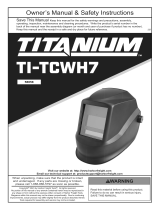
Page 3For technical questions, please call 1-888-866-5797.61610
SAFETYOPERATIONMAINTENANCE SPECIFICATIONS
IMPORTANT SAFETY INFORMATION
When using helmet, basic safety precautions should always be followed to
reduce the risk of personal injury and damage to equipment.
The warnings, cautions, and instructions discussed in this instruction manual cannot cover all possible
conditions and situations that may occur. It must be understood by the operator that common sense
and caution are factors which cannot be built into this product, but must be supplied by the operator.
Read all instructions before using this helmet!
WARNING
Welding and Plasma Cutting Produce
TOXIC FUMES.
Exposure to welding or cutting exhaust
fumes can increase the risk of developing
certain cancers, such as cancer of the
larynx and lung cancer. Also, some
diseases that may be linked to exposure
to welding or plasma cutting exhaust
fumes are:
• Early onset of Parkinson’s Disease
• Heart disease • Ulcers
• Damage to the reproductive organs
• Inflammation of the small intestine or
stomach • Kidney damage
• Respiratory diseases such as
emphysema, bronchitis, or pneumonia
Use natural or forced air ventilation and
wear a respirator approved by NIOSH to
protect against the fumes produced to
reduce the risk of developing the above
illnesses.
1. Do not use the Welding Helmet if the lens is
cracked, if the lens or sensors are dirty, or if
the lens or front retaining frame is loose.
2. Keep work area clean. Cluttered
areas invite injuries.
3. Observe work area conditions. Do not use
welding helmets in damp or wet locations.
Do not expose to rain. Keep work area well
lit. Do not use auto-darkening helmets in the
presence of flammable gases or liquids.
4. Keep children away. Children must never
be allowed in the work area. Do not let them
handle this helmet. Dress properly. Do not
wear loose clothing or jewelry. Keep your hair,
clothing and gloves away from moving parts.
5. Store idle equipment. When not in use,
helmets must be stored in a dry location
to inhibit rust. Always lock up helmets
and keep out of reach of children.
6. Dress properly. Do not wear loose clothing
or jewelry as they can be caught in moving
parts. Protective gear is essential to protect
against welding rays, some examples are: a
leather welding apron, welding sleeves, jeans
without cuffs, work boots. Wear restrictive
hair covering to contain long hair.
7. Use eye and ear protection. When welding,
wear ANSI-approved impact safety goggles under
the Welding Helmet. Wear a NIOSH-approved
respirator and hearing protection when welding.
8. Stay alert. Watch what you are doing, use
common sense. Do not weld when you are tired.
9. Check for damaged parts. Before using any
helmet, any part that appears damaged should be
carefully checked to determine that it will operate
properly and perform its intended function. Check
for alignment and binding of moving parts; any
broken parts or mounting fixtures; and any other
condition that may affect proper operation. Any
part that is damaged should be properly repaired
or replaced by a qualified technician. Do not use
the helmet if any switch does not operate properly.
10. Replacement parts and accessories. When
servicing, use only identical replacement parts.
Use of any other parts can render helmet ineffective,
possibly causing eye damage, and will void the
warranty. Only use accessories intended for
use with this helmet. Approved accessories
are available from Harbor Freight Tools.
11. Do not weld if under the influence of
alcohol or drugs. Read warning labels on
prescriptions to determine if your judgment
or reflexes are impaired while taking drugs.
If there is any doubt, do not weld.

















